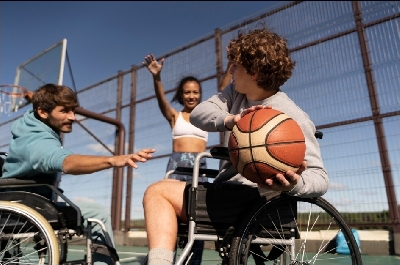This post was published by a guest. The views expressed are those of the author and do not necessarily reflect the views of Scified.com.
Sports can significantly enhance one’s mental and physical well-being and establish a sense of community. Sports can do even more for those with disabilities, as sports significantly boost their emotional well-being and reinforce their self-esteem. It also provides them with opportunities to engage socially.
Sports have evolved beyond just competitions; now, there are recreational leagues designed to include every individual, regardless of their abilities. Such leagues enable individuals with disabilities to excel and help shatter the stereotype that defines a person’s physical ability to participate in sports. With proper assistance, everyone can embrace the true spirit of sports.
More Than Movement: Building Identity and Confidence
Likewise, for people with disabilities, sports activities are not just physical exercises; they represent something more profound. It's about exploring possibilities rather than confirming limitations. From wheelchair basketball to blind football, adaptive sports programs enable athletes to showcase their talents, sharpen their skills, and celebrate their accomplishments. These achievements play an important role in reconstructing one's and society’s perception.
With adaptive sports and inclusive competitions' growing visibility, fans have more ways to support and follow them. Online platforms like MelBet help highlight tournaments, showcase top talent, and bring broader recognition to leagues that deserve the spotlight.
A Platform for Advocacy and Change
Athletes with disabilities are speaking up about accessibility, representation, and equality in sports and society. They are changing the narratives and challenging stereotypes from social media, interviews, or even during medal-winning moments.
For example, paralympians are no longer athletes but have become powerful advocates for inclusion and innovation. Their visibility alone helps change policies, build infrastructure, and create new prospects for other disabled athletes.
The Role of Media in Changing Perceptions
Media coverage shapes perception. The representation of athletes with disabilities is improving, such as through broadcasts of the Paralympics and social media pages of adaptive athletes. Positive change is occurring.
When coverage of adaptive sports is approached with the same fervor as other professional sports, it reinforces that these athletes are not simply “inspiring,” but rather talented, competing athletes deserving of attention. This change is crucial for full integration into the sports world.
A Community Beyond the Game
For people who suffer from disabilities, especially those who feel alone, coming together as a team can be life-transforming. It helps them form a social support system they never had before. One of the key commonalities amongst all humans is socializing. For new people, such as athletes, sports have become a powerful tool for eliminating gaps.
Stigma plays a significant role in discrimination and social division. Sports shift the worldview from individuals' incapacity to their capabilities, like cooperation, hard work, spirit, and everything positive. In schools and other organizations, such programs are designed to embrace different cultures and people with disabilities more. As accessibility is provided, the disabled have more avenues to show their skills.
Want to see more of this impact in action? MelBet often shares stories and highlights that feature athletes of all abilities making waves in their communities and beyond.
Innovation That Levels the Playing Field
New forms of technology are positively impacting people with disabilities. Due to technological advancements, athletes with disabilities now have access to new high-tech safety features in wheelchairs, prosthetics, wearables, and engineering appliances. Now, even coaching and scouting are more effortless with AI-enabled technologies and virtual training programs customized to suit each athlete's skills and requirements.
Let us explore the full potential of technology in assisting athletes who are disabled:
- Prosthetics that dynamically respond in real-time to movement.
- Warm-ups that are custom-fitted to the individual’s measurements.
- Remote-accessed coaching that adapts lessons on the go.
- Devices that track the rest periods and rehabilitation phases during active recovery.
- Mobility devices tailored to particular sporting activities and settings.
These tools help athletes train, compete, and grow on their terms, proving that adaptive doesn’t mean limited.

Changing the Culture, One Match at a Time
Creating specific sports for disabled people is not the only issue; their involvement in more general sports activities is also essential. As a minimum, this covers the improved accessibility of the stadium, sports wheelchair marketing, and equal media attention.
With regard to opportunity, children with disabilities can be viewing in their significant life events someone like them at the height of success. The perspective of fans changes drastically when adaptive competition is introduced with unrestrained enthusiasm and joy. The effect is far-reaching, affecting everything from home life to workplace culture, and even schools.

5 Best Pennsylvania Casino Apps for Real Money in 2025
Mobile gaming has completely transformed downtime. Pennsylvania casino apps let you play slots, hit the blackjack tables, or spin roulette w...

The Healing Power of Massage: Your Path to Better Health
Introduction to the Therapeutic Benefits of Massage Massage therapy has evolved from a simple method of relaxation into a comprehensive practice with...

Address Collection: Modern Methods for Accurate Data Capture
Accurate address collection has become a mission-critical necessity for organizations that rely on precise customer information to streamline logistic...

uWin Launches Exclusive VIP Prize Draw to Win Behind-the-scenes Tour of Silo — in Support of PORA
uWin has announced an extraordinary new prize draw offering television fans the chance to win an exclusive VIP set tour of Silo, one of Apple TV+&rsqu...

KYC in Gaming – What It Is and Why It Matters
The world of online gaming has come a long way over the past decade. But as the industry continues to grow, so do the risks that come with it. Today, ...


